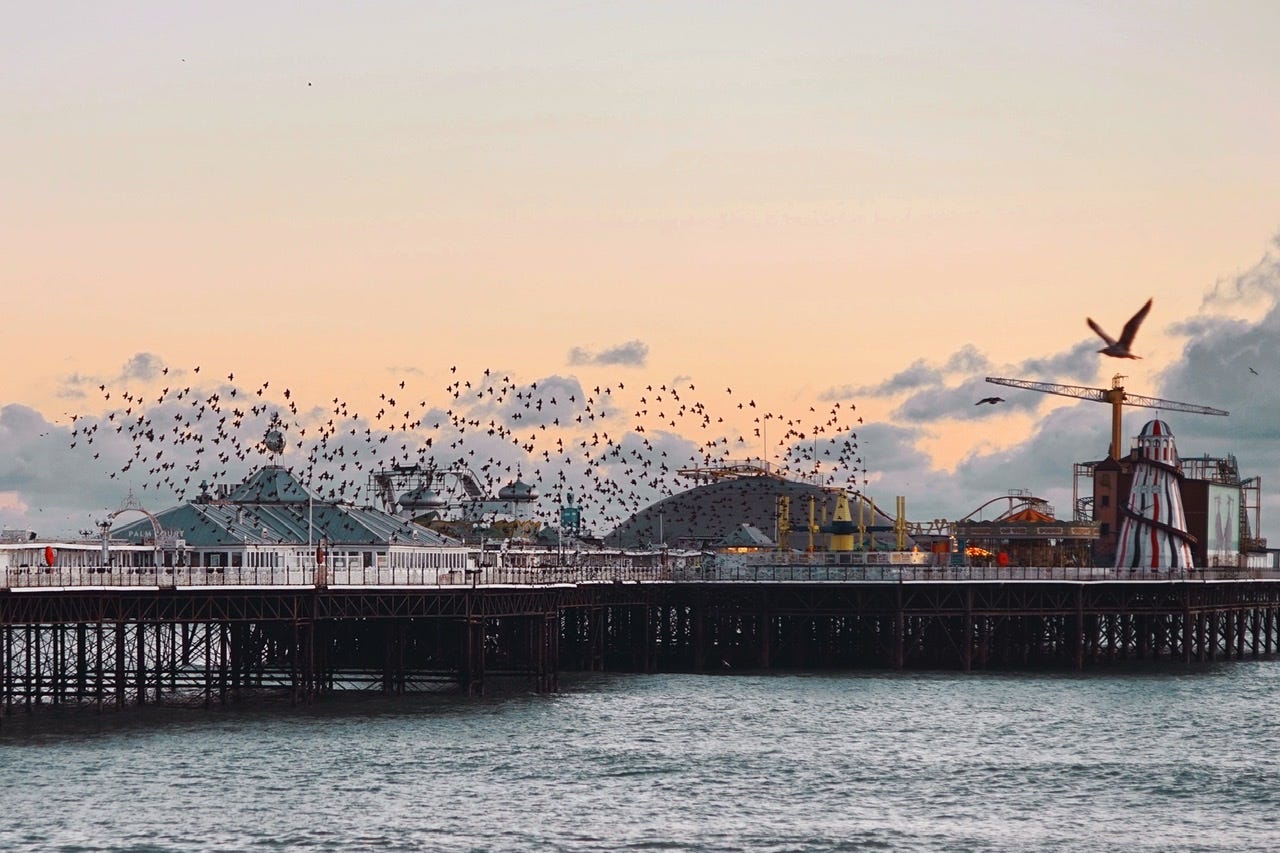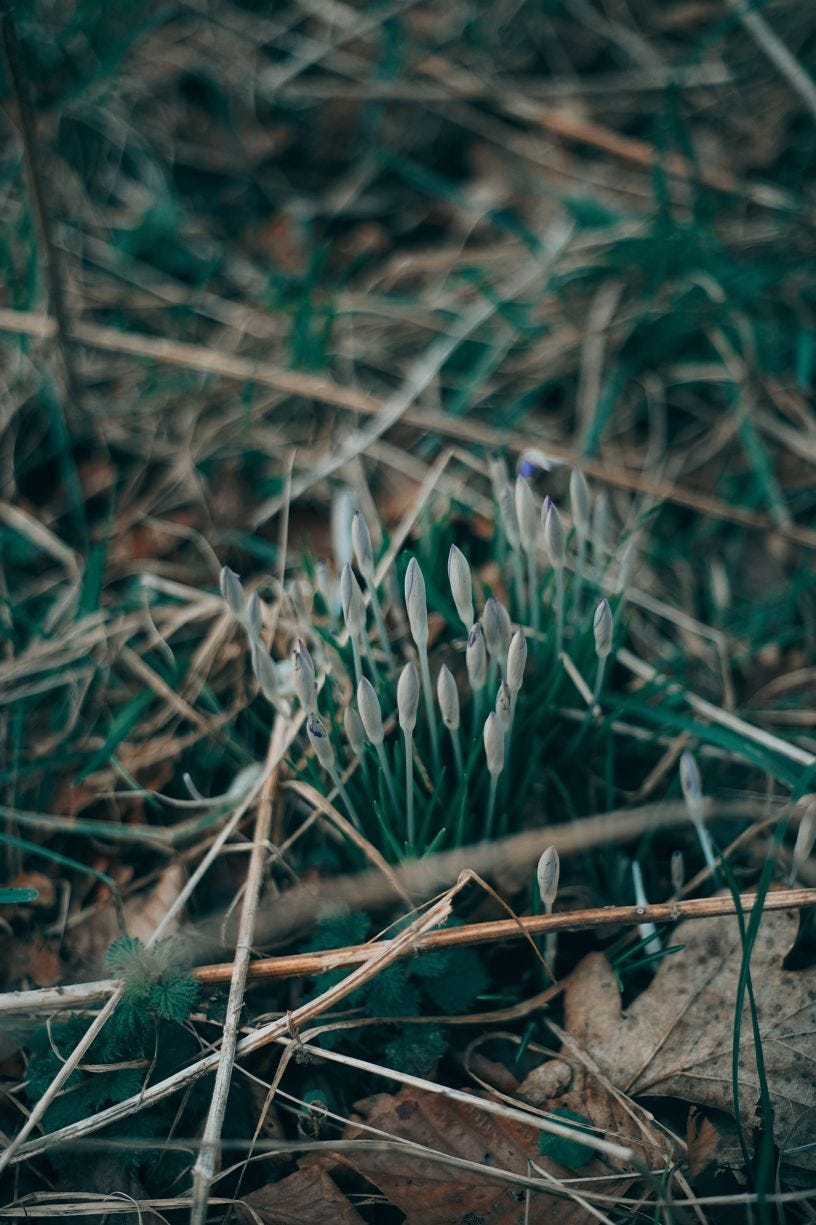Spring has sprung, gentle reader. Welcome to a new edition of enda lettere, a newsletter about walks, words, and the 24 seasons of the year. Follow me through some notes and walks: in South London, Brighton, and Oxford, where I’ve been chasing the first glimpse of spring.
⚘
Market
The first thing I notice is the crowd. That, of course, is a lie. First I notice the piebald dachshund slightly taller than the grass, running, running, tumbling in the burning magnesium-brightness of noon. Then I notice the crowd.
There is a Sunday market at Crystal Palace Park, a bustling affair of sizzling hot plates, vibrant street food, fresh produce, and most importantly, good bread. It’s like the League of Nations convening for a leisurely intercultural exchange—clutching my German bread and French cheese I’m just a hungry Hungarian waiting patiently with the Israelis and the Portuguese and the Polish. We are all Others here, while queueing for vegan Korean burritos, Argentinian steaks, and crawfish rolls. It is a relief, that nobody asks where the accent is from, nobody is interested in my foreignness.
I am invisible under the wispy sky and the lace-work of tree branches, where a pair of rose-ringed parakeets land to watch the commotion.
Lingering winter—flowers lying in wait
This is the time of yokan (余寒), or lingering winter in the Japanese calendar. A transitory state, lingering winter means something different every day. One day it’s the cold still dwelling in the bark of trees, then icy sunshine, mist rising over the pond and people talking at the gates of the park. And then a windless night: winter receding.
All living things lie in wait and a suppressed impatience is palpable in the morning hours. And when a warm wind comes, gently, secretly sweeping through the streets, the next day the first trees bloom. How, I ask. I’ve been paying close attention, breath held, and yet, I missed the exact moment. I go around the neighborhood and notice white and pink petals unfurling, and then the first crocuses (or croci?), a miniature Milky Way of white and yellow on the lawn.
Global temperatures are rising at an unprecedented rate, but environmental responses are often difficult to recognize and quantify. Long-term observations of plant phenology, the annually recurring sequence of plant developmental stages, can provide sensitive measures of climate change and important information for ecosystem services. [...] Community-wide first flowering advanced by almost one month on average when comparing all observations before and after 1986 (p < 0.0001). [...] Compared to trees and shrubs, the largest lifeform-specific phenological shift of 32 days is found in herbs, which are generally characterized by fast turnover rates and potentially high levels of genetic adaptation.
I quell the delight and hope I feel upon seeing the first flowers. No matter how I crave milder days or the world in bloom, opening up to something new after the dead of winter, it is awfully early.
Murmuration about to end
Then a few colder days, a windstorm: I buy a pristine duffel coat at the flea market and feel smug and warm on the pier, while watching the starlings. These days I hear their whimsical whistles in the garden, too—slowly, the murmuration is coming to an end. But until then they’ll put up a few spectacular shows, for they are professionals, contracted until the end of winter season.

Cats in the garden
The neighbors must have realized that something was in the air, for they released their cats back into the backyards. First, a large black cat appears in what I like to call “the garden”, which is, in reality a nonsensical empty plot between the houses. The garden is the realm of my neighbors, the Foxes, King Fox and Fox the Younger, and they are both greatly upset by the intruder. The black cat is blissfully ignorant: he cannot see the Foxes and doesn’t seem to recognize the smell. He gingerly makes his way through the lawn and is given a chase by the formidable tabby who is rapidly conquering the entire neighborhood.
I see the black cat on a mild afternoon again, he is sunning himself under the old elm tree, which is alive with birds. Oblivious to the chatter of the birds above, the cat falls asleep. There is peace in on earth and in the tree, where the goldfinches, redwings, dunnocks, robins, tits, and wrens gather.
Nonsuch
The next station is Carshalton Beeches. The doors of the train close, shutting out a shaft of healthy sunshine. People drift in and out of focus. They are real like I am not, distinct, visible, and very much alive. Still I keep forgetting them, like I am forgetting the young woman in the expensive summer dress and high-heeled sandals. The sun warms my cheeks. Somewhere in this afternoon there is the promise and the memory of summer. Every year I forget how to loll about in the fields and meadows and parks. Every year I re-learn it.
The next station is Ewell East. Walking the London LOOP is like tracing the contours of an unruly amoeba: I can’t be too certain whether this is Surrey or London or somewhere in between? Henry VIII dreamed up his grandest palace here. A palace from scratch. Closest to his favorite hunting spot, the entire village of Cuddington had been razed, the rubble replaced by Nonsuch Palace. The name rolls like toffee on my tongue. There was no such building near and far indeed, the palace rivaled the Château de Chambord, a prime example of European Renaissance architecture (no, scratch that, let’s call it Gesamtkunstwerk). The only difference: you can still visit Chambord, but Henry’s plutocratic pièce de résistance had been torn down and sold to cover gambling debt as if it was nothing. Nonsuch had vanished, no contour, no trace, no ruins remained, only watercolours and slightly exaggerated drawings of its once splendid frontage survived.
There is hope in the scalability of transience.
Dream
More often than not I dream. I dream wide awake, with maps and timetables at hand. I dream of walks and words, and the edgeland of slumber is thin. On my maps I trace a trail around Rochester, to the Thames foreshore and back, to Kit’s Coty, a Neolithic burial chamber.
And then I dream of travelling to the rolling hills for the excavation, convinced that I’ll find it there. It’s arduous work, finding and digging up the large slabs of stone, lifting them. Once the burial chamber is visible, I slip between the stones, because time itself is there. I become one with time, I become the past, or what’s left of it. There is nothing else left to do.
⚘
For better or worse, I’ll go on a walk next week, so watch the ‘gram for impromptu stories. And if any of these little vignettes resonated with you, tell me all about it, and please share ‘enda lettere’ with your friends and foes.





